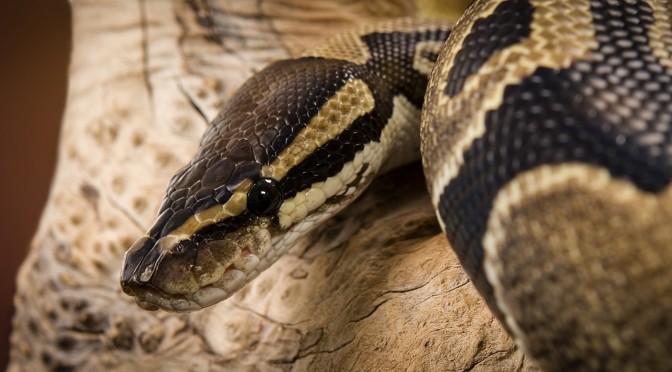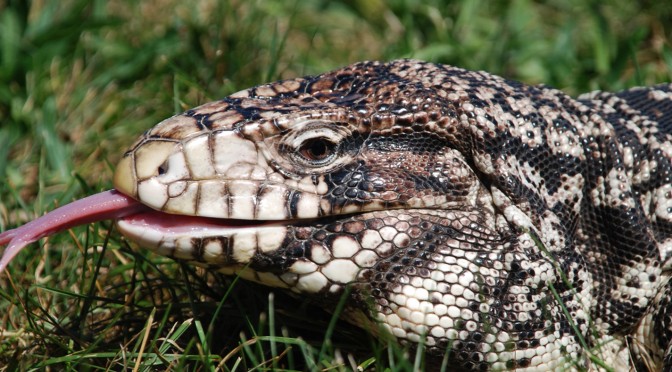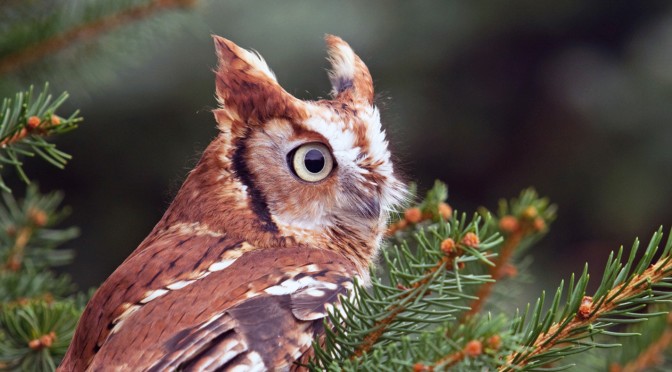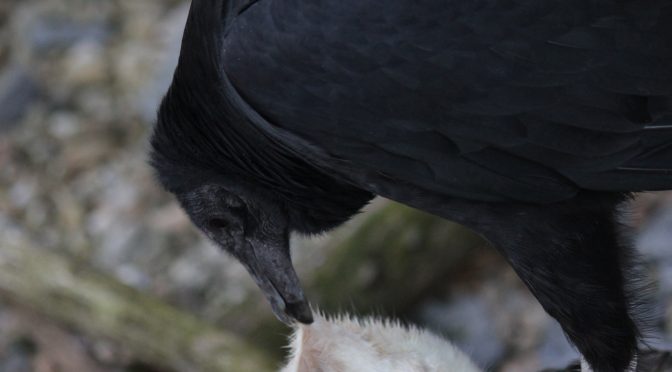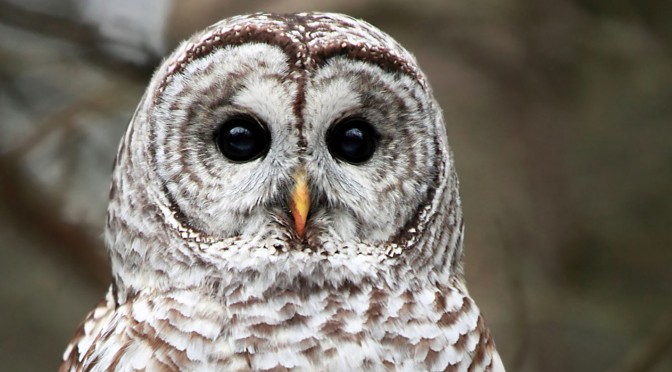NOTE: Education Animals are “behind-the-scenes” animals & only appear to the public during Educational events. This includes scheduled events or programs such as daily animal mingles, private onsite programs, and zoo reaches. For more information, please reach out to edureservations@lvzoo.org.
Program and General Information
Ball pythons are a non-venomous, constrictor species native to the bushlands and savannas of Central and Western Africa. They are a medium-sized snake ranging from 3-6 feet with females being larger than males. They are typically a light brown-green and black in color, with a tan-yellow underbelly and splotches of brown/tan along their body. Ball pythons are carnivores that prey primarily on rodents. Breeding season occurs from mid-September through mid-November. The male will use his spurs to clasp onto a female during mating. Females are oviparous and lay about 4-12 eggs. After about 75-80 days the eggs will hatch. Hatchlings are independent and will mature between 18 months – 4 years. Due to their docile nature, ball pythons have become popular pets. By purchasing and owning an exotic animal, you could be supporting the illegal exotic pet trade so be sure to do your research and only purchase from reputable breeders.
Diet
Ball pythons are primarily rodent hunters, but will also hunt birds, amphibians and other reptiles.
They are largely nocturnal preferring to hunt for their food at night. Heat- seeking pits above the mouth help the snakes to figure out the distance and direction of warm-blooded prey.
Habitat and Range
Ball pythons are native to Western and Central Africa, and can be found primarily in Benin, Ghana, and Togo. Ball Pythons prefer savanna, sparsely wooded plains, and dry bushland habitats.
They are mainly terrestrial snakes and spend the majority of their time on the ground, but may occasionally be found in water or in low stumps and foliage.
Common Physical Features
Ball pythons are a smaller, heavy bodied snake with a small head and short tail. They average 3-6 feet in length and weigh between 2-4 pounds; females are generally larger than males. They are primitive snakes that still possess a pelvic girdle and “vestigial” limbs (an early stage presence of hind limbs, left from evolutionary adjustments). They are typically a light brown-green and black in color, with a tan-yellow underbelly and splotches of brown/tan along their body.
Adaptations: Ball pythons are terrestrial, nocturnal hunters and have adapted to hunt better at night. Above their lip they have heat-seeking pits, which are able to detect wavelengths of light in the infrared spectrum and the signal is processed visually, meaning, they are capable of seeing a thermal image of their surroundings giving them an advantage in hunting in the dark as well as seeking out refuges when temperatures are too hot or cold.
Snakes have an interesting way of sniffing out their prey items. Like other reptile species, ball pythons have a Jacobson’s organ in the roof of their mouth. They will stick out their tongue in order to pick up scent particles in the air or from the surface of objects. Their tongues are forked at the end, splitting in two directions in a V-shape, allowing the snake to pick up scent particles from two different directions. When the tongue is brought into the mouth to the Jacobson’s organ, the organ will process the information and determine which side of the tongue the scents came from. This will inform the snake which direction to go to find that scent. (If it picks up the scent on the left fork, then it knows to go to the left. If it picks it up on the right, then it goes to the right. And then if it picks up the scent on both forks then it knows the scent is coming from straight ahead. )
Ball pythons are ambush predators; they will sit and wait for their prey to come to them. Ball Pythons (like other snakes) do not have moveable eyelids. Instead, they have a special clear scale that covers the eyes, making them appear to be always awake. Not having eyelids allows the Ball Python to refrain from blinking and keep its cover when it is camouflaged. Once a prey is close enough, the ball python will grab the prey and wrap tightly around it.
They have powerful body muscles to squeeze and suffocate prey. Snakes have a highly flexible skull that allows them to swallow their prey whole. Contrary to popular belief, they do not actually unhinge/dislocate their jaws to swallow prey because there isn’t anything to actually unhinge/dislocate! A snake’s jaw is only loosely joined to its skull by ligaments, which allows the jaw to be solid enough to bite, but flexible enough to expand for swallowing. Once prey is inside the mouth, the snake alternate using the left and right sides of the upper and lower jaws to “walk” the prey to the back of the throat where powerful muscles will help force the prey down the rest of the body. To better visualize the movement of the jaw imagine laying on your stomach and crawling using your elbows and knees to move. That is similar to how the snake’s upper and lower jaws work to push the food into the mouth and down the throat.
Behavior and Life Cycle
Breeding season for the ball python typically occurs from February to April during the rainy season. Males will seek out a female and use their spurs to clasp on during mating. Females are oviparous and lay about 4-12 eggs inside an abandoned animal burrow or log. Once the eggs are laid, females will coil around them for temperature and humidity control. Since pythons cannot regulate their internal body temperature, they cannot incubate their eggs per se; instead, they raise the temperature of their eggs by small movements of their body. Eggs will hatch after 75-80 days and hatchlings will be completely independent. Hatchlings will take anywhere from 18 months – 4 years to mature. Males typically mature faster than females.
Conservation Messaging
Purposeful Pet Ownership
Although a decent sized snake, ball pythons have a very gentle disposition and tend to curl into a ball when threatened rather than immediately bite. This has made them quite popular in the pet trade. Many people don’t realize, however, just how much work goes into caring for reptile species. Reptiles require specific lighting, humidity, space, nutrients, substrate, heating, and if they do not receive the proper care then that reptile’s health can decline rapidly. It can be difficult to find veterinarians that are equipped to care for reptiles if they get sick.
By purchasing and owning an exotic animal, you could be supporting the illegal exotic pet trade. Oftentimes these exotic pets are taken out of their natural habitat to be sold in the pet trade, which can be detrimental to wild populations. One more exotic pet in captivity is one less animal in the wild which is resulting in species population numbers dropping drastically.
What can we do?: Be sure to fully research any pet before buying one. While you may think a reptile would make a cool pet, it’s important to know all of the care that goes into providing that animal with the best possible welfare, and as mentioned before reptiles require a lot of extra care. It is important to make sure that if you do buy an exotic pet that you are buying it from a reputable breeder, someone who knows how to properly care for the animal and hasn’t taken that animal from its natural habitat.
Do not release an unwanted pet into the wild. While you may think that you are doing something good by releasing the animal back into the wild, animals that have been kept under human care often do not know how to survive on their own out in the wild and could end up getting hurt or dying if left to their own devices.
Fun Facts
- Coiling around the eggs and using body movements to maintain temperature is one of only a few documented cases of parental behavior in snakes. The mother will stay to warm and protect her young until they hatch and will not eat for this whole time period.
- The oldest recorded Ball Python reached 48 years of age in human care.
- Ball Pythons are also called Royal Pythons because it is believed that Cleopatra used to keep them coiled around her wrists.
- Ball Pythons like to burrow, and although they spend most of their lives on the ground, this species of python is able to climb and be perfectly comfortable up in the trees.
- The name Ball derives from its tendency to, when stressed, curl into a tight “ball” with their heads hidden inside, often for long periods of time.
Bibliography
- deVosjoli,Philippe. 1990. The Care and Maintenance of Ball Pythons, Advanced Vivarium Systems, Lakeside, CA, pp. 2-6.
- Mehrtens, John. 1987. Living Snakes of the World, Sterling Pub., NY, p. 62. Stidworthy, John. 1971. Snakes of the World, Glosset & Dunlap, NY, p.58. Internet.
- https://www.reptilia.org/care-sheets/snakes/ballpython
- https://www.hoglezoo.org/meet_our_animals/animal_finder/ball_python/
- https://www.oaklandzoo.org/animals/ball-royal-python
- https://www.saczoo.org/wp-content/uploads/2016/12/Ball-Python-1.pdf
